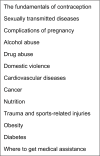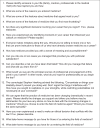Exposing medical students to expanding populations
- PMID: 25834472
- PMCID: PMC4371899
- DOI: 10.2147/AMEP.S77894
Exposing medical students to expanding populations
Abstract
Physicians are required to advocate for and counsel patients based on the best science and the interests of the individual while avoiding discrimination, ensuring equal access to health and mental services. Nonetheless, the communication gap between physician and patients has long been observed. To this end, the Institute for the Public Understanding of Health and Medicine of the Rutgers University New Jersey Medical School has expanded its efforts. This report describes two new programs: a legacy lecture series for medical students and an international "experience", in Huancayo, Peru, for medical students and faculty. The MiniMed outreach program, now in its ninth year and first described in this journal in 2012, was designed to empower the powerless to communicate more effectively with clinicians, thus improving both the effectiveness of the physician-patient relationship and health care outcomes. The approach of the two new programs and their effects on patients, particularly the underserved, and medical students and faculty, are outlined in the following article.
Keywords: Kintock Group; MiniMed program; Newark Renaissance House; equal access; role modeling; underserved populations.
Figures
Similar articles
-
Evaluation of the Program in Medical Education for the Urban Underserved (PRIME-US) at the UC Berkeley-UCSF Joint Medical Program (JMP): The First 4 Years.Teach Learn Med. 2015;27(2):189-96. doi: 10.1080/10401334.2015.1011650. Teach Learn Med. 2015. PMID: 25893941
-
Medical School Outcomes, Primary Care Specialty Choice, and Practice in Medically Underserved Areas by Physician Alumni of MEDPREP, a Postbaccalaureate Premedical Program for Underrepresented and Disadvantaged Students.Teach Learn Med. 2017 Jul-Sep;29(3):351-359. doi: 10.1080/10401334.2016.1275970. Epub 2017 Mar 2. Teach Learn Med. 2017. PMID: 28632012
-
From the History of the Croatian Dermatovenereological Society - The Croatian Medical Association and an Overview of Important Information Regarding the Journal Acta Dermatovenerologica Croatica.Acta Dermatovenerol Croat. 2018 Dec;26(4):344-348. Acta Dermatovenerol Croat. 2018. PMID: 30665489
-
The evolution of a required research program for medical students at the University of Washington School of Medicine.Acad Med. 2006 Oct;81(10):877-81. doi: 10.1097/01.ACM.0000238240.04371.52. Acad Med. 2006. PMID: 16985345 Review.
-
[Clinical pharmacy practice education in master's course of Meijo University in affiliation with medical school].Yakugaku Zasshi. 2009 Aug;129(8):897-909. doi: 10.1248/yakushi.129.897. Yakugaku Zasshi. 2009. PMID: 19652496 Review. Japanese.
Cited by
-
Testing of a dental student-administered multidisciplinary health promotion program.J Family Med Prim Care. 2019 Oct 31;8(10):3230-3235. doi: 10.4103/jfmpc.jfmpc_563_19. eCollection 2019 Oct. J Family Med Prim Care. 2019. PMID: 31742147 Free PMC article.
-
Advances in medical education and practice: role of massive open online courses.Adv Med Educ Pract. 2017 Aug 21;8:603-609. doi: 10.2147/AMEP.S115321. eCollection 2017. Adv Med Educ Pract. 2017. PMID: 28860891 Free PMC article. Review.
-
Broken Promises to the People of Newark: A Historical Review of the Newark Uprising, the Newark Agreements, and Rutgers New Jersey Medical School's Commitments to Newark.Int J Environ Res Public Health. 2021 Feb 22;18(4):2117. doi: 10.3390/ijerph18042117. Int J Environ Res Public Health. 2021. PMID: 33671581 Free PMC article. Review.
References
-
- American College of Physicians Racial and ethnic disparities in health care: a position paper of the American College of Physicians. Ann Intern Med. 2004;141:226–232. - PubMed
-
- Brody DS. The patient’s role in clinical decision-making. Ann Intern Med. 1980;93(5):718–722. - PubMed
-
- Pellegrino ED. Editorial: Medical ethics, education, and the physician’s image. JAMA. 1976;235(10):1043–1044. - PubMed
-
- Starfield B, Steinwachs D, Morris I, Bause G, Siebert S, Westin C. Patient-doctor agreement about problems needing follow-up visit. JAMA. 1979;242(4):344–346. - PubMed
LinkOut - more resources
Full Text Sources
Miscellaneous




